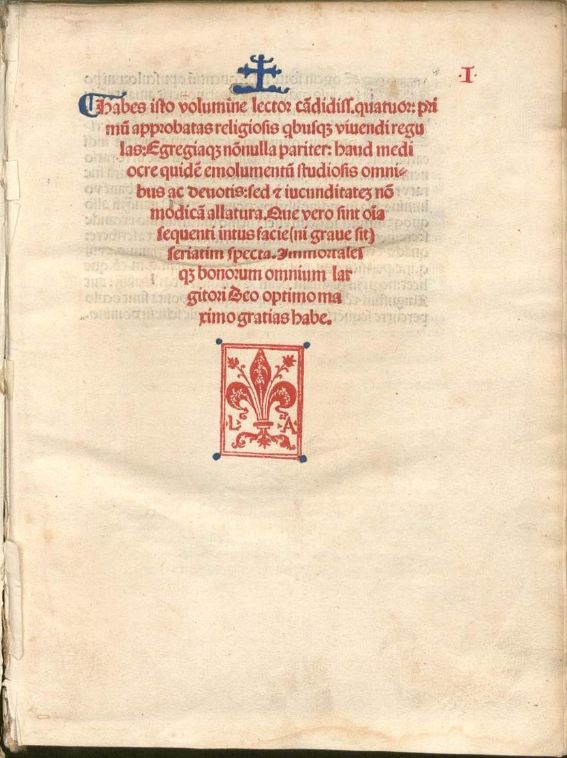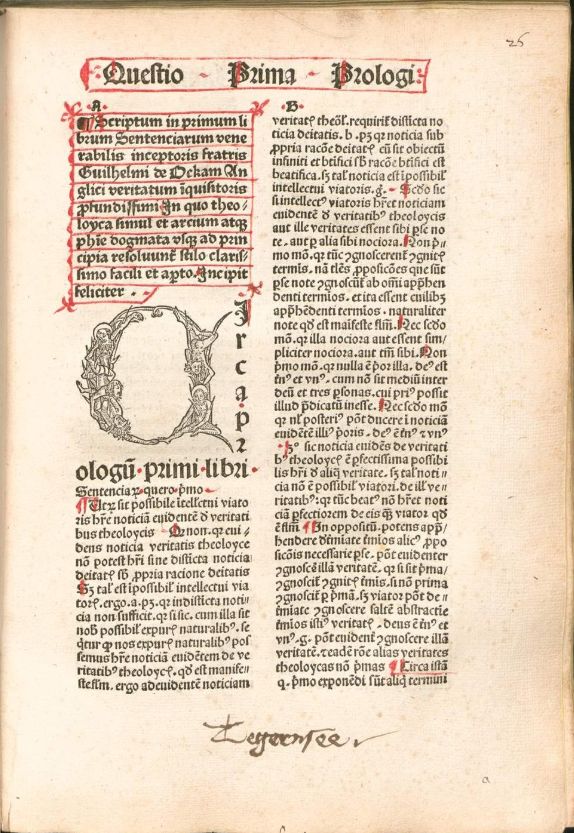Printed books surviving from Canterbury medieval libraries
By the year 1500, the printing industry was over forty years old and had spread to all the major centres of Europe. Many institutional libraries were starting to add printed books to their collections and were even discarding manuscript copies from their shelves in favour of the new ‘modern’ products of the printing press. It is not easy to document this process from surviving books as many must survive without any indication of their original owner, whether personal or institutional. It is still the case that relatively few British libraries have fully researched and made available the provenances of items in their collections, though this situation is slowly improving.
The new online database of Medieval Libraries of Great Britain, based on the work of Neil Ker in his Medieval Libraries of Great Britain (second edition 1964, supplement 1987) and the Corpus of British Medieval Library Catalogues (1990– ) is now available at http://mlgb3.bodleian.ox.ac.uk.

The database has an Advanced Search facility with an option of searching for printed items only, excluding manuscripts. Overall, the MLGB3 database records 446 printed books surviving from monastic libraries. The pattern of survival of printed books can be very varied. Selection of ‘Durham’ as the provenance and ‘Durham’ as the present-day location shows that Durham Cathedral still has 35 of the printed books which were in the library of the Priory at the time of the Dissolution of the monasteries; however, a further 70 Durham printed books survive in other libraries, mainly in England. Hereford Cathedral still owns 22 of its late-medieval printed books; none are recorded as surviving elsewhere. Printed books do survive from the monasteries which were suppressed at the Dissolution. Of suppressed abbeys with large medieval libraries, only two printed books are recorded as surviving from Glastonbury and one from St Albans.
So far as is known, none of the printed books of the medieval library of Christ Church Cathedral Priory survive in the modern library at Canterbury. Just three of its books are recorded in the database as surviving elsewhere.

Regulae monasticorum.
Venice: Johannes Emericus, de Spira, for Lucantonio Giunta, 1500.
Ampleforth Abbey, shelfmark C.V.220.
Inscriptions: ‘Liber dompni Thome goldstone monachi ecclesie xi cant’ ordinis sancti benedicti : ex dono dompni Edwardi bockyng monachi eiusdem ecclesie et ordinis’.
Another inscription, scored through, of D. Edward Bockyng with the price iij s. iiij d.(?): ‘liber dompni Edwardi Bockyng monachi ecclesie xi cant’ ordinis sancti benedicti’.
ISTC ir00135000
MLGB 1025
Gregorius, Moralia.
Paris: Ulrich Gering and Berthold Rembolt, 1495.
Chichester, Cathedral, shelfmark Case B 04.
Inscription: ‘liber comparatus per [. . . . . .] monachum ecclesie xi
cant’ bachalarium in theologia precii –- vii s’.
ISTC ig00431000
MLGB 1215
Pius II, Epistolae familiares.
Lyons: Jean de Vingle, 1497.
Wisbech, Wisbech & Fenland Museum, shelfmark C.3.8.
ISTC ip00722000
MLGB 1361
Only one printed book seems to survive from the Benedictine Abbey of St Augustine: a 1496 copy of Boethius at the Bodleian Library
Boethius, De consolatione philosophiae.
[Lyon: Jacques Maillet, c. 1496].
Oxford, Bodleian Library, shelfmark 4° B 2 Art.Seld.
Inscription: ‘Liber fratris Willelmi Godmersham monachi sancti
Augustini Cant” (top of title-page, erased).
ISTC ib00799700
MLGB 6853
For Canterbury’s Franciscan convent, there is again a single survivor: a 1483 edition of William of Ockham’s commentary on the Sentences at Lambeth Palace:

William of Ockam, In primum librum Sententiarum Petri Lombardi.
[Urach : Conrad Fyner],1483.
London, Lambeth Palace Library, shelfmark 1483.5.
ISTC io00014000
MLGB 1646

There must have been more printed books in all three of these Canterbury religious houses by the mid-1530s and also in other local establishments such as the Dominicans and the Augustinian friary at the Whitefriars. Fifteenth-century books and their provenances are much better recorded than those printed in the sixteenth century, so there may be further finds to be made.
Images: from digitised copies of ISTC ir00135000 and ISTC io00014000 (Bayerische Staatsbibliothek) and from MLGB 1646 (Lambeth Palace Library).
MLGB: The Medieval Libraries of Great Britain database became unavailable in December 2024, updated version lauched in Summer 2025.